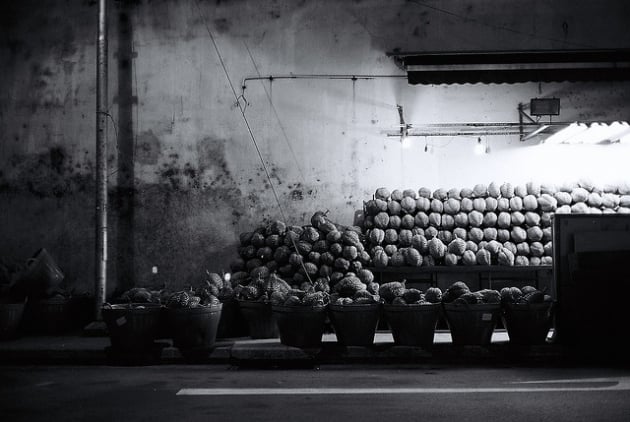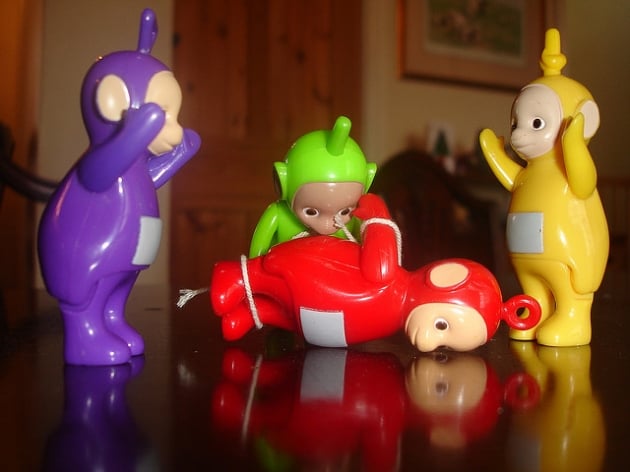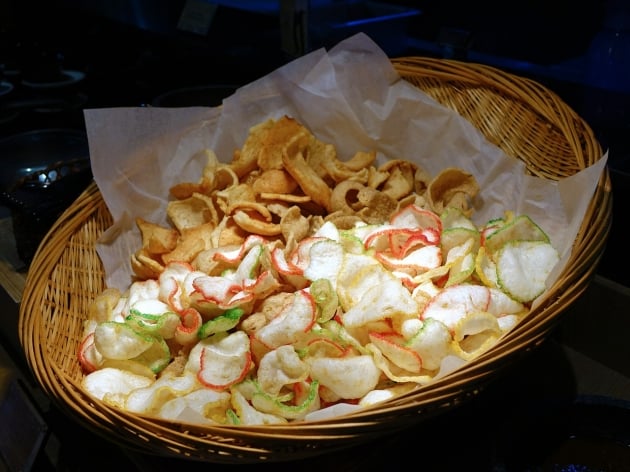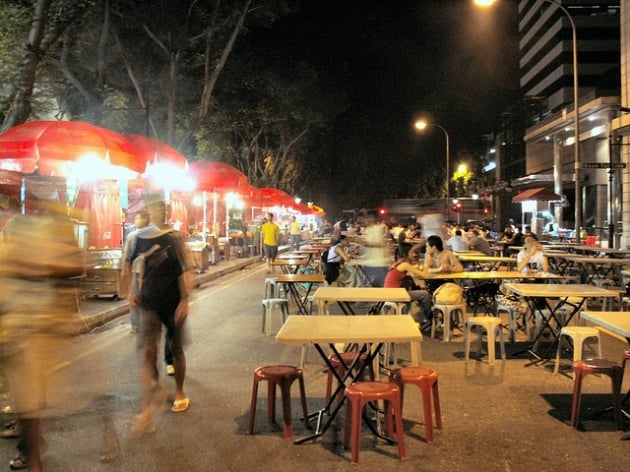Most Famous Singapore Urban Legends
All of us know Singapore as the bustling metropolis we live in. However, despite being the practical Singaporeans that we are, local urban legends still linger in our minds. Whether or not we have heard of them before, these urban legends have the potential to send shivers down our spines.
Remember those old wives’ tales that our parents told to scare us from doing dangerous things? Well, that’s just one type of urban legend. Then, there are the dubious ones that are spread by word-of-mouth. Today, in an age where our lives revolve around the internet, urban legends are given new life on social media.
Here are some of Singapore’s most famous urban legends.
1. Death By Durian and Alcohol
 Source: Flickr
Source: Flickr
We’ve been told about the lethal combination that is drinking alcohol with durian. After you’ve eaten the King of Fruit, drinking alcohol immediately after should be a no-no unless you want to find yourself dead.
The Chinese believe that foods are considered either “cooling” or “heaty” and because both durians and alcohol are “heaty”, mixing them would overheat the body, causing complications such as indigestion, stomach discomfort and in some cases, death.
Explanation:
There is little scientific evidence to prove this. In fact, a lot of research has been conducted to prove otherwise. A study published in the Singapore Medical Journal where mice were given both durian and alcohol proved inconclusive.
While it has been suggested that the high sulphur content in durians impairs the body’s processes to break down alcohol, it mostly gives you a bad feeling in your stomach.
Ultimately, it’s about moderation – too much of a good thing could indeed be bad for you. But do not take our word for it because we will not be liable for your death if you decide to test this out for yourself.
2. Revenge Angel & The HIV Syringe
 Source: Flickr
Source: Flickr
In 2011, a rumour started about a woman nicknamed “Revenge Angel” The Revenge Angel went around Zouk and The Butter Factory, attacking clubbers with a syringe filled with HIV-tainted blood. She was exacting her revenge after contracting the virus from someone she met in the club, or so the rumour went.
I remember when this rumour started circulating amongst my friends. On one hand, I was angry that such a thing could even happen. Although hell hath no fury like a woman scorned, taking revenge on innocent people crosses a line. On the other hand, I was concerned for my own safety because The Butter Factory was one of my favourite hangouts.
Things got so out of hand that both Zouk and The Butter Factory lodged police reports to put a halt to this damaging rumour.
Explanation:
As unbelievable as this one seems, variations of this rumour have been spread all over the world since the 1990s. More commonly know as the “pin prick attack,” this rumour gained momentum through chain e-mails. I’m sure many have also heard of the one where a cinemagoer unknowingly sits on an infected needle in the cinema, only to find out that he contracted HIV months later. Another variation went on about how an infected needle was hidden in the coin retrieval slot of public phones.
This rumour was quickly debunked. Doctors have stated that for transmission to happen, the blood must be freshly drawn and the needle must really penetrate the skin. So, a “prick” wouldn’t do the trick.
Nobody can know for sure why these rumours started. I speculate that it’s one of those stories meant to frighten people from going to these establishments. Rumours can do so by causing widespread panic because it circulates rapidly on the internet. Even so, we have to take everything we read on the internet with a pinch of salt – there are some things that are simply ridiculous.
3. The Children That Played Above Your Flat
 Source: Flickr
Source: Flickr
Many Singaporeans live in high rise buildings. Those of us who do, remember the times we were annoyed with the people who just couldn’t stop playing with marbles in the unit above – especially when we were trying to sleep. While I remember trying to ignore them, others have had trouble sleeping because they claim that these sounds are paranormal in nature.
Those who have cry ghost cite the impossibility of children playing with marbles when they find out that there is the unit directly above them is vacant. As a result, they jump to the conclusion that these sounds are caused by the restless spirits of young children.
Explanation:
This urban legend has stood the test of time even though investigations have been conducted to disprove it. Explanations include the distorted sound of water running through pipes and the contraction of building materials such as steel due to the cooling of the weather at night. I’m no scientist but these reasons appear legitimate.
Even though these scientific explanations can easily allay any fears of ghostly apparitions residing in your block, this urban legend lives on because of how much these sounds have become part of our everyday lives. Logically, it’s impossible that there are spirits living above every single apartment… Right?
4. The Extra Long Train Stop Between Yio Chu Kang and Khatib
 Source: Flickr
Source: Flickr
If you are like me, you may have wondered why there is such a significant distance between Yio Chu Kang and Khatib stations. In fact, it is the longest distance between any two stations in Singapore. Apparently, there was supposed to be another station in between them that was meant to serve the patrons of Disneyland!
Yes, rumour has it that in the 1990s, Disney offered to build one of their iconic theme parks in the Lentor area. However, plans for the park fell through and Disney decided to build one in Hong Kong instead.
Explanation:
This urban legend is plausible. In the 1990s, Singapore was rapidly developing and was poised to become an Asian Superpower. It would not be surprising if a multinational company like Disney wanted to take advantage of that.
On the other hand, It is difficult to ascertain whether this one is fact or fiction because evidence to suggest the credibility of this story is sparse. However, there must be other reasons why there is not another station in between Yio Chu Kang and Khatib. For one, the area between these stations largely consists of Lower Seletar Reservoir. Logically, a lack of space for residential development in the area would mean that building a station there would be unnecessary.
Until definitive proof about this supposed deal can be found, we are left to speculate if Singapore would have been more magical if “The Happiest Place on Earth” was just an MRT ride away.
5. Stepping On Hungry Ghost Offerings
 Source: Flickr
Source: Flickr
During the seventh lunar month every year, I make sure to be extra careful when walking around the neighbourhood, especially when I see offerings laid out by the sidewalk. I’ve been told that anyone who steps on these offerings will anger the roaming spirits and evil will befall the perpetrator.
Unfortunately, I’ve had first hand experience with this superstition – I fell down and skinned my knee when I accidentally stepped on an incense stick. It could be a sheer coincidence but my father actually suggested that I could have offended “someone out there.” I still have the scar to remind me of this incident.
The belief is that the Gates of Hell are open during this period and practices such as preparing ritualistic food offerings and the burning of joss paper are performed to appease the spirits that have come out. Even during getai performances, the first row of seats is left empty for “them”.
Explanation:
While these practices have roots in Buddhism and Taoism, being in multicultural Singapore necessitates that we respect such rituals even if we may not believe in them.
Admittedly, this one is difficult to prove because it is solely based on religious beliefs and therefore, subjective. Nevertheless, it is called The Hungry Ghost Festival and I do not want to offend anyone who would be best described as “hangry,” human or otherwise.
6. Tinky Winky, Dipsy, Laa Laa, Po
 Source: Flickr
Source: Flickr
“Over the hills and far away, Teletubbies come to play” – that’s how every episode of the popular BBC children’s television series started. According to a local urban legend, the dolls “come to play” in the middle of the night.
When Teletubbies started airing in Singapore, it became so popular their dolls flew off the shelves. Soon after, many reported seeing and hearing these dolls talk in the middle of the night. Others added that these dolls were satanic and possessed by evil spirits. There were widespread concerns over these baby-faced dolls but eventually, talk about them died down as the series became defunct..
Explanation:
While I agree the Teletubbies are strange looking humanoid creature, rumours about haunted dolls are hard to believe. There was also a time when Furbies were plagued with similar gossip about them being able to talk despite having no batteries. It just seems like we have an anxiety over inanimate toys.
These rumours were likely inspired by the stories of Robert The Doll, more commonly known as Chucky in popular culture, as well as the now overused story of Annabelle.
Like many other urban legends, this one is hard to explain definitively because a lot of the details stem from hearsay. Thinking about it today, the paranoia surrounding these dolls that caused me to throw away my Tinky Winky is silly.
7. The Mystery Behind the $1 Coins
 Source: Remember Singapore
Source: Remember Singapore
This urban legend affects you and me because it involves the humble $1 coin that we keep in our pockets. Did you know that its design was derived with Feng Shui in mind?
In mid-1980s, when construction for the MRT began, then Prime Minister, Lee Kuan Yew consulted Venerable Hong Chuan, a well-respected Feng Shui master, about the plans. He warned that extensive tunnelings and large quantities of metal being driven into the bedrock would counteract with the positive Feng Shui of the island. His proposed solution was to ensure that every Singaporean carry a bagua, an octogonal shape that represents trigrams derived from Taoist cosmology.
Being the multicultural and multireligious country that Singapore is, forcing every single Singaporean to do so would be impossible. However, PM Lee reportedly came up with an ingenious idea to embed the bagua into the design of the $1 coin. This allows every Singaporean, regardless of race and religion, to unwittingly carry a bagua . Eventually, that led to the birth of the $1 coin that we have grown so accustomed to today.
Explanation:
Whether or not there was a reason for the design of the $1 coin, it started its circulation in September of 1987, which coincidentally, is two months before the commencement of the MRT service. The close timings of these two events seem to link them together.
There isn’t a reason to complain about this anyway because Singapore has grown from strength to strength since then. Something else that propagated this urban legend is the octagonal road tax labels that ensures all vehicles would be carrying and displaying a bagua too. Coincidence? I’m not sure anymore.
Now, this urban legend is one that many Singaporeans are familiar of, especially if they subscribe to the rules of Feng Shui. There are other cases where Feng Shui have informed design decisions, like for the Singapore Flyer and Marina Bay Sands. While this urban legend does not harm anyone, it’s weird to think that simple design decisions can hugely impact the prosperity of our nation.
8. Warding Off Rain With Chilli And Onions
During an interview at the Formula One night race in 2008, Prime Minister Lee Hsien Loong mentioned this practice of using chilis and onions to prevent the rain from coming. Specifically, people believe that putting chilis and onions on a satay stick and planting them at the bottom of a tree will ward off the rain.
Today, many locals still abide by this practice for outdoor events such as barbeques. Others have reported seeing it being done before national events held outdoors such as the Singapore Night Festival and the National Day Parade. So, if you were curious as to why the National Day Parade has never been cancelled due to inclement weather, this could be the reason.
Explanation:
This superstition started when Singapore was a small fishing village. Malay fishermen did this to ensure that they would have ideal weather for fishing. It is believed that this superstition stemmed from a bomoh or black magic origin.
There is definitely no scientific reason for this practice. It is improbable that this simple act can be done to keep the rain away. This tradition has definitely been passed down via word-of-mouth.
As for a reason why it very rarely rains during the annual National Day Parade, modern technology has blessed us with a method to keep the rain away – cloud-seeding.
9. Pointing at the Moon
 Source: Flickr
Source: Flickr
As children, I’m sure that many of us have heard this warning before – do not point your finger at the moon or else your ears would be cut off. Then, we are provided with little or no explanation for this. Yet, we take heed and are conscious not to do violate this warning.
Explanation:
The little explanation that I got regarding this urban legend seem to point towards a culturally-backed origin. With tales about Chang Er, the goddess of the moon, being retold to children over and over again, the Chinese hold the belief that the moon is sacred. This could be the reason why this superstition exists.
Even though I remembered being a rebel as a kid who pointed at the moon despite the warnings, the believability of this urban legend seems to be a question of your own beliefs. To me, this one seems implausible because the idea of your ears falling off with no reason is quite irrational.
10. Makcik Keropok
 Source: PixaBay
Source: PixaBay
Two years ago, there were strange rumours about an old lady who went house-to-house in the evenings selling keropok. She was known as Makcik Keropok, and was believed to harbor a dark secret.
She went around knocking on doors. You’re advised to not open the door if you see a suspicious old lady with keropok. However, if you do open the door, quickly buy her keropok or she’ll release a Pontianak into your home!
This story felt iffy to me when I first heard it – it sounds like a bunch of makciks decided to create a story to boost their keropok sales! However, despite thinking of it as a scam and laughing it off, I must admit to being afraid when I opened the door to a makcik selling her keropok one fateful day.
Explanation:
I found out that the rumour started gaining traction on a segment called, Misteri Jam 12 or Midnight Mystery on a local radio station, where a listener called in to relate his experience with said Makcik Keropok. Then, when I asked my mother about this urban legend, she said that it was similar to the story about the Kom Kom, a ghost who kidnaps children at dusk.
After some investigation, I discovered that this story was crafted by parents during the good old kampung age to scare their children from playing outside the house after dark. Perhaps, the Makcik Keropok story was also created to ensure that children did not stay out too late.
More recently, Berita Harian reported that a lady has started making her way around the island with her child asking for milk in exchange for a cursed plush toy. Even though she sounds like Makcik Keropok with a different mask, I can’t help but feel a little creeped out at the thought of another “makcik” going around.
11. What’s In The Satay Club Gravy?
 Source: Flickr
Source: Flickr
While the Satay Club is no more, there was an urban legend about the peanut sauce served during its time from 1970 to 1995 that was unsavoury, to say the least.
The Satay Club’s satays were so popular that rumours started spreading about hawkers adding soiled sanitary napkins or used underwear in their gravy to ensure that customers were addicted to the satays served there. While knowledge of this could easily turn off people from eating satay ever again, The Satay Club stayed popular until 2005.
Explanation:
Investigations have been conducted to debunk this urban legend. While many have linked this practice to a bomoh ritual originating from Indonesia, others have suggested that this urban legend was merely gossip started by rival satay sellers as a dirty tactic to ward off the competition – no pun intended.
Since the rumours were started, the National Environment Agency conducted frequent checks on stallholders but there was no evidence of unsanitary practices that compromise the satays. In the end, I think that this rumour was started by someone who wanted sabotage the significant popularity of the Satay Club.
Believe It or Not
When it comes to urban legends, I’m inclined to think that there are logical explanations to every single one of them. But sometimes, I find myself abandoning certain scepticisms because of unexplainable experiences.
Ultimately, whether or not these urban legends change your impression of this country, is dependent on your own beliefs.
Have any other theories to explain these urban legends? Or do you have any other urban legends to share? Share them with us in the comments below!